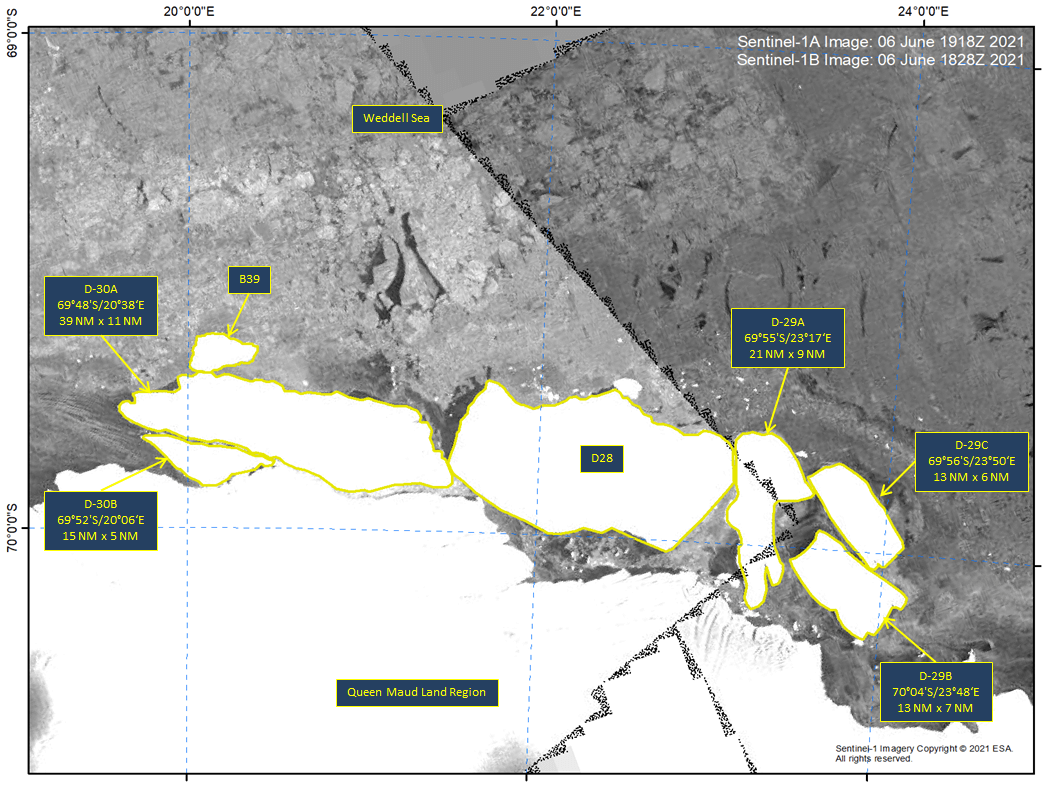Iceberg D-28 Collided with Ice Shelves in the Queen Maud Land Region of Antarctica Creating Five New Icebergs as a Result
By LT Falon M. Essary, USN
NIC.PAO@noaa.gov
U.S. National Ice Center
June 7, 2021
Suitland, MD — The U.S. National Ice Center (USNIC) has confirmed D-29 and D-30 have calved from the Baudouin and Borchgrevink ice shelves respectively. Almost immediately after calving from the collision with D-28, icebergs D-29 and D-30 calved into smaller icebergs resulting in five total (D-29A-C, D-30A-B). Calved from the Baudouin Ice Shelf as of June 6th, iceberg D-29A was centered at 69° 55' South, 23° 17' East and measures 21 nautical miles on its longest axis and nine nautical miles on its widest axis. D-29B was centered at 70° 04' South, 23° 48' East and measures 13 nautical miles on its longest axis and seven nautical miles on its widest axis. Iceberg D-29C was centered at 69° 56' South, 23° 50' East and measures 13 nautical miles on its longest axis and six nautical miles on its widest axis.
Calved from the Borchgrevink Ice Shelf, Iceberg D-30A was centered at 69° 48' South, 20° 38' East and measures 39 nautical miles on its longest axis and 11 nautical miles on its widest axis. D-30B was centered at 69° 52' South, 20° 06' East and measures 15 nautical miles on its longest axis and five nautical miles on its widest axis.
The new icebergs were first spotted USNIC Analysts Michael Lowe, and Christopher Readinger, and confirmed by Christopher Readinger using the Sentinel-1A and 1B images shown below.
Iceberg names are derived from the Antarctic quadrant in which they were originally sighted. The quadrants are divided counter-clockwise in the following manner:
A = 0-90W (Bellingshausen/Weddell Sea)
B = 90W-180 (Amundsen/Eastern Ross Sea)
C = 180-90E (Western Ross Sea/Wilkesland)
D = 90E-0 (Amery/Eastern Weddell Sea)
When first sighted, an iceberg’s point of origin is documented by the USNIC. The letter of the quadrant, along with a sequential number, is assigned to the iceberg. For example, C-19 is sequentially the 19th iceberg tracked by the USNIC in Antarctica between 180-90E (Quadrant C). Icebergs with letter suffixes have calved from already named icebergs, where the letters are added in sequential order. For example, C-19D, is the 4th iceberg to calve off the original C-19 iceberg.
The National Ice Center is a tri-agency operational center represented by the United States Navy (Department of Defense), the National Oceanic and Atmospheric Administration (Department of Commerce), and the United States Coast Guard (Department of Homeland Security). The National Ice Center mission is to provide the highest quality strategic and tactical ice services tailored to meet the operational requirements of U.S. national interests and to provide specialized meteorological and oceanographic services to United States government agencies.

For more information, please contact:
National Ice Center
Command Duty Officer
Voice: (301) 943-6977
E-mail: nic.cdo@noaa.gov
Twitter: @usnatice
Facebook: @usnatice
The U.S. National Ice Center is a tri-agency center operated by the Navy, NOAA, and Coast Guard and provides global to tactical scale ice and snow products, ice forecasting, and related environmental intelligence services for the United States government.